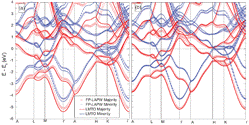Department of Physics and Astronomy: Publications and Other Research

Kirill Belashchenko Publications
Document Type
Article
Date of this Version
2012
Citation
Physical Review B 85, 214405 (2012); DOI: 10.1103/PhysRevB.85.214405
Abstract
Electrical resistivity of heavy rare-earth metals has a dominant contribution from thermal spin-disorder scattering. Here this spin-disorder resistivity is calculated for the Gd-Tm series of metals in the paramagnetic state. Calculations are performed within the tight-binding linear muffin-tin orbital method using two complementary methods: (1) averaging of the Landauer-Büttiker conductance of a supercell over random noncollinear spin-disorder configurations, and (2) linear response calculations with the spin-disordered state described in the coherent potential approximation. The agreement between these two methods is found to be excellent. The spin-disorder resistivity in the series follows an almost universal dependence on the exchange splitting. While the crystallographic anisotropy of the spin-disorder resistivity agrees well with experiment, its magnitude is significantly underestimated. These results suggest that the classical picture of slowly rotating self-consistent local moments is inadequate for rare-earth metals. A simple quantum correction improves agreement with experiment but does not fully account for the discrepancy, suggesting that more complicated scattering mechanisms may be important.


Comments
Copyright 2012 American Physical Society. 2012 Used by permission.